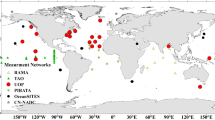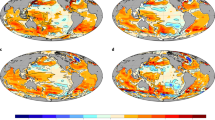Summary
Maps showing the distribution of global solar, net terrestrial and net radiation over the Indian Ocean area have been prepared from available observations, supplemented by calculations based on other meteorological measurements. Annual and monthly maps for four representative months January, April, July and October for global solar and net radiation are presented.
Global solar radiation shows minima over the equatorial and monsoon regions, and maxima over land in the high pressure belts of the northern and southern hemispheres along the tropics of Cancer and Capricorn, the highest values of the order of 220 kcal/cm2/year occuring over North Africa and Arabia. While there is very little latitudinal variation over the ocean during the southern summer, the variations are marked during the northern summer. The geographical distribution is mainly zonal except in the low latitudes, where areas of higher or lower radiation are distributed according to regions of higher or lower amounts of cloudiness.
Net radiation over the ocean is always positive and greater than that on land. The distribution is mainly zonal, maxima occuring over the sea in the tropics, with the highest values in the North Arabian Sea and the ocean areas to the northwest of Australia. Minima occur over land in the arid regions of both hemispheres and in the monsoon areas where global solar radiation itself is low. There is very little variation over the ocean during the southern summer but variations are large during the northern summer.
Zusammenfassung
Auf Grund des verfügbaren Beobachtungsmaterials, das durch Berechnungen an Hand weiterer meteorologischer Messungen ergänzt wurde, wurden Karten über die Verteilung der Globalstrahlung, der effektiven langwelligen Ausstrahlung und der totalen Strahlungsbilanz für das Gebiet des Indischen Ozeans und seiner Umgebung entworfen. Im nachfolgenden sind die Jahres- und die Monatskarten für die vier charakteristischen Monate Januar, April, Juli und Oktober für die Globalstrahlung und die totale Strahlungsbilanz wiedergegeben.
DieGlobalstrahlung zeigt Minima in den Äquatorial- und den Monsungegenden, Maxima über Land in den Hochdruckgürteln der Nord- und der Südhalbkugel in der Gegend der Wendekreise, wobei die höchsten Werte von etwa 220 kcal/cm2 und Jahr über Nordafrika und Arabien auftreten. Während im Südsommer die Breitenvariation über dem Ozean nur sehr klein ist, ist sie im Nordsommer stärker betont. Die geographische Verbreitung ist in der Hauptsache zonal gegliedert, mit Ausnahme der niederen Breiten, wo die Gebiete höherer oder niedererer Globalstrahlungssummen entsprechend den Unterschieden der Bewölkungsverhältnisse verteilt sind.
Dietotale Strahlungsbilanz ist über dem Ozean durchwegs positiv und größer als über Land. Die Verteilung ist in der Hauptsache zonal, wobei die Maxima über dem Meer in den Tropen auftreten mit Höchstwerten in der Nordarabischen See und in den Meeresgebieten nordwestlich von Australien. Minima liegen über Land in den Trockenregionen beider Hemisphären sowie in den Monsungebieten, wo die Globalstrahlung vermindert ist. Über dem Ozean sind die Unterschiede der Strahlungsbilanz während des Südsommers nur gering, während des Nordsommers dagegen größer.
Résumé
Au vu des observations disponibles complétées de valeurs calculées en partant d'autres données météorologiques, on a établi des cartes de la répartition du rayonnement global, du rayonnement effectif émis à grandes longueurs d'ondes et du bilan radiatif total, et cela pour la région de l'Océan Indien et ses environs. On donne maintenant des cartes du rayonnement global et du bilan radiatif total pour l'année entière et pour quatre mois caractéristiques, à savoir: janvier, avril, juillet et octobre.
Lerayonnement global présente des minimums dans les régions équatoriales et de moussons. Les maximums en sont concentrés sur terre dans les zones à hautes pressions des hémisphères nord et sud situées dans le voisinage des tropiques du Cancer et du Capricorne. Les plus hautes valeurs, de l'ordre de 220 kcal/cm2 par année, se trouvent sur l'Afrique du Nord et sur l'Arabie. Alors que les variations dues à la latitude sont très faibles sur l'océan durant l'été austral, elles sont plus prononcées durant l'été boréal. La répartition géographique est en général zonale à l'exception des basses latitudes où les régions à plus faibles ou plus fortes quantités de rayonnement global sont réparties selon les différences de la nébulosité.
Lebilan radiatif total est toujours positif sur les océans et plus grand que sur terre. La répartition en est avant tout zonale. Les maximums se trouvent sur la mer sous les regions tropicales et les plus hautes valeurs s'enregistrent dans le nord de la Mer d'Oman ainsi que sur la mer au nord-ouest de l'Australie. Les minimums se recontrent sur les terres dans les régions arides des deux hémisphères ainsi que dans les régions à mousson où le rayonnement global est réduit. Audessus des océans, les différences du bilan radiatif sont faibles durant l'été austral, plus importantes durant l'été boréal.
Similar content being viewed by others
References
Albrecht, F.: Strahlung und Wärmehaushaltsuntersuchungen während einer Seereise durch den Indischen Ozean im Juni 1949. Ber. Deutsch. Wetterd. U.S. Zone7, No. 42, 5–10 (1952).
Ashbel, D.: New World Maps of Global Solar Radiation during IGY 1957–58. Hebrew University, Dep. Climatol. Meteorol. Jerusalem, 1961.
Berliand, T. G.: Actinometric Reference Book. Hydro-meteorol. Publ. Off., Leningrad, 1964.
Black, J. N.: Distribution of Solar Radiation Over the Earth's Surface. Arch. Met. Geoph. Biokl., Ser. B,7, 165–189 (1956).
Budyko, M. I.: The Heat Balance of the Earth's Surface. Gidro-meteorologicheskoe izdatel 'stvo, Leningrad, 1956.
Budyko, M. I.: Atlas of Heat Balance, Moscow, 1963.
Jacobs, W. C.: Sources of Atmospheric Heat and Moisture over the North Pacific and North Atlantic Oceans. Ann. N.Y. Acad. Sci.,44, 19–40, 1943.
Landsberg, H. E., H. Lippmann, Kh. Paffen, andC. Troll: Weltkarten zur Klimakunde. Springer-Verlag, Berlin, 1963.
Mosby, H.: Verdunstung und Strahlung auf dem Meere. Ann. Hydr. Marit. Met.7, 64 (1936).
Robinson, G. D.: Surface Measurements of Solar and Terrestrial Radiation during the IGY and IGC. Annals IGY, Pergamon Press32, Meteorology II, Radiation 17–61 (1964).
Sauberer, F., andI. Dirmhirn: Über den Strahlungshaushalt der Ozeane auf der Nordhalbkugel. Arch. Met. Geoph. Biokl., Ser. B6, 113–127 (1954).
Schulze, R.: Zum Strahlungsklima der Erde. Arch. Met. Geoph. Biokl., Ser. B,12, 185 (1963).
Sverdrup, H. U.: Oceanography for Meteorologists. New York, 1945.
U. S. Navy Marine Climatic Atlas of the World. Vol. III. Indian Ocean, 1957.
Monatskarten für den Indischen Ozean, 3. Aufl., Deutsch. Hydrograph. Inst., Hamburg, 1960.
World Meteorological Organization, Catalogue of IGY/IGC Meteorological Data WMO, No. 135, IGY 4, 1962.
Author information
Authors and Affiliations
Additional information
With 10 Figures
Published by permission of the Director General of Observatories, New Delhi, India.
Rights and permissions
About this article
Cite this article
Mani, A., Chacko, O., Krishnamurthy, V. et al. Distribution of global and net radiation over the Indian Ocean and its environments. Arch. Met. Geoph. Biokl. B. 15, 82–98 (1967). https://doi.org/10.1007/BF02319113
Received:
Issue Date:
DOI: https://doi.org/10.1007/BF02319113




